
The conventional AM detectorTo detect amplitude modulation, Linrad computes the amplitude as the square root of the power of the baseband signal. The output routines expect a complex signal on which the frequency shift specified by the BFO can be applied. In AM mode the detected amplitude is stored as the real part for the output routines while the complex part is set to zero. Linrad setts the BFO frequency and phase to zero in AM mode, thereby making the output routines send the detected amplitude directly to the loudspeaker. This way of sending the detected AM to the loudspeaker was the easiest to implement given the routines already in place.Figure 1 is a screen dump from 40 meters. This screen is made from a recording made Jan 11 2004 at about 1300 UTC. The hardware used is the WSE converter chain connected to a Delta44 soundcard placed in a PC with a PentiumIII at 650 MHz. The frequency was set to 7.275 MHz in Linrad. For this recording the system was run with two channels, but no antenna was connected to channel 2 while about 10 meters of wire was connected to channel 1. |

|
|
Fig. 1. A section of the 40 meter broadcast band as seen on the Linrad screen. In daytime, with a poor antenna, the number of broadcast stations that overcome the local computer noise is not very large. The frequency scale is incorrect by 2.5 kHz, the strongest station is at 7235 kHz. There is a carrier visible every 5 kHz except at 7250 kHz. The signal at about 67500 Hz on the frequency scale, 7265000 Hz when the calibration error is taken into account, is selected and its baseband spectrum is shown in the baseband graph. In figure 1, the baseband spectrum and the baseband waterfall graph do not convey any interesting information because only one antenna has been connected. One thing can be seen however in the baseband graph. The noise floor of the WSE hardware is about 6 dB below the noise floor received from the very poor antenna. The carrier has to be 15 to 20 dB above the surrounding noise floor in the main spectrum with the parameters of figure 1 to allow reception of AM modulation Here is 30 seconds of the loudspeaker output when Linrad processes the recording with the settings of figure 1. am_normal.wav (774188 bytes) AM detected by coherent processingLinrad is designed for the reception of weak and perturbed signals. AM is the same kind of modulation as the simple Morse code on/off keying. The information is contained in the amplitude while the phase of the signal should just rotate at the constant speed given by the frequency.By selecting two filters, one for the entire signal with modulation included and another which is very narrow and only will let the carrier through, it is possible to do a coherent detection. This is equivalent to extracting the carrier phase with a PLL system, then extracting the amplitude by mixing the VCO of the PLL with the full bandwidth signal. The coherent processing, regardless whether it is done with a filter or with a PLL system is a linear process as long as the signal is strong enough for the carrier phase to be established correctly. Mixing the carrier in quadrature with the full bandwidth signal gives two output signals that contain 50% of the noise each. The in-phase signal contains the AM modulation while the out-of-phase component contains any FM modulation that might be present. By feeding the in-phase signal to both ears and rejecting the out-of-phase signal, one can ideally gain 3 dB S/N. This is the purpose for which the coherent routines were once designed. In real life it is more complicated however. The carrier of a Morse coded signal is often frequency modulated and therefore the coherent routines allow some options. These options are useful for the reception of shortwave broadcast stations because they can also be frequency modulated to some extent. Coherent mode 2 sends the AM modulation to one ear and the FM modulation to the other ear. Figure 2 shows the screen when part of the |

|
|
Fig. 2. A small part of the beginning of the recording displayed in figure 1. Here displayed while Linrad is doing coherent processing. AFC and second FFT is enabled, to give a plot of the received frequency and S/N. It is not required for the coherent processing to work. The AM broadcast stations are placed accurately on channels with 5 kHz spacing. There is typically more than one station on each channel and with a conventional AM detector it is difficult to hear the weaker of two signals on the same frequency. If, however, the phase of the weaker signal differs well from the phase of the stronger one, the modulation of the weaker signal may show up essentially as FM on the summed carrier while the modulation of the stronger signal shows up essentially as AM. In such cases it may be of some help to use coherent mode 2 and stereo head phones in case the weaker station is the interesting one. This file: am_coh.wav (1335340 bytes, stereo) is the output of Linrad processing the very same 30 seconds of the recording shown in figures 1 and 2 as was processed in normal AM mode to produce The Linrad output am_normal.wav (774188 bytes, mono). (The same file as linked to above.) If you speak German, download the two files, listen to them with stereo head phones and see how much more you can understand about what is spoken underneath the beautiful Piano Concerti Nos.21 "Elvira Madigan" by Mozart. The carrier has S/N= 40 dB in 200 Hz bandwidth or 25 dB in 3 kHz. The voice in German is about 10 dB weaker and would be seriously affected by noise even if it were the only station present. The way the coherent processing works to help receiving a weaker AM signal that is present under a stronger one can be understood as follows: At times when the two carriers are in phase or out of phase, the amplitudes simply add and the weak modulation can be heard under the the strong signal in an ordinary AM detector. Using the coherent processing presents the same information to the "AM ear", the only advantage is that some of the noise is moved to the other ear where it is less disturbing. At times when the two carriers are 90 degrees out of phase, the amplitudes do not add in the usual fashion, the sum is the square root of the sum of squares so if one signal is strong and the other weak, the amplitude is nearly constant. At such times, the weak signal can not be heard with an ordinary AM detector and it is not presented to the "AM ear" by the coherent processing. When a vector is modified by the addition of a small and orthogonal one, the length (amplitude) is nearly unchanged, the change comes in the direction (phase). Consequently the modulation of the weak signal appears in the "FM ear" at times when it is absent in the "AM ear". Most of the time it is of course present in both ears because the phase between the two stations varies at random. Normal AM detection vs coherent processing on a single, strong broadcast stationShortwave signals are subjected to selective fading. There is multipath propagation and the different waves arrive with a substantial time difference. This means that the different waves will add at some frequencies while they will cancel att other frequencies. Figure 3 shows 25 seconds of the 40 meter band from 7245 to 7285 kHz nominal. The signal at 7572.5 on the frequency scale is VOA (Voice of America) on 7255 kHz. This is a very strong signal, well above the noise floor. When listening to it on a conventional radio, one will hear exactly the same as one gets into the Linrad loudspeakers when selecting the normal AM detector ( Coh mode = 0 ). |

|
|
Fig. 3. Voice of America on 7255 kHz. This 30 second sequence is received by Linrad both with a conventional AM detector and with coherent detection. Download the .wav files and compare! The audio output from the sequence displayed in figure 3 when detected with the conventional AM detector: voa_normal.wav (561196 bytes, mono) has the caracteristic sound of shortwave radio, the selective fading sometimes reduces the amplitude of the carrier causing a very distorted reception. One can see the selective fading in fig. 3 as bands that slope at nearly 45 degrees from the upper left to the lower right on the modulation sidebands of the VOA signal. The bands are separated by about 3 kHz which means that the two main waves that differ in path length by N wavelengths at 7255 kHz differ by N+1 wavelengths at about 7258 kHz. At for example 15.48 on the time scale, the carrier amplitude is very low and at that time the modulation is severely distorted when reception is done using a simple AM detector. By enabling coherent detection ( Coh mode 2 one avoids distortion caused by insufficient carrier amplitude. The received modulation is not AM, the sidebands have been subjected to different phase shifts and there is a strong FM component in the modulation. The stereo output from Linrad: voa_coh.wav (1097772 bytes, stereo) is best listened to stereo head-phones, but compared to the conventional AM detector, using the AM channel only (Coh mode 3 ) is also a substantial improvement. The coherent processing of Linrad is closely related to independent sideband reception. If the two output signals are subjected to a 90 degree phase shift, one relative to the other and the sum and differences are taken, the two new signals will be the upper sideband and the lower sideband. In case both sidebands are to be used, there will not be any improvement since this kind of phase sensitive addition/subtraction is equally well done in the brains of the listener. In case one wants to use one of the sidebands only because the interference level is too high on one side, the recommended procedure is to use SSB mode. Then one can easily reject one sideband completely. To SM 5 BSZ Main Page |